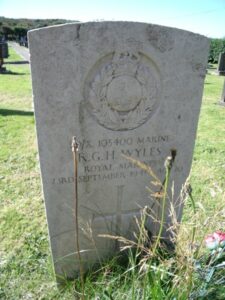Goodwick is a small fishing village, lying west of Fishguard, in the parish of Llanwnda. From 1887 the Great Western Railway linked Goodwick to the rest of the country, and the village grew rapidly as a result, being home to Fishguard Harbour. The names of the fallen of Goodwick during both World Wars are held in a Remembrance book in the Parish Church. To originally create this page, Barrie Brickle kindly sent me a copy of the page which holds the names of the fallen of the Second World War, and Mike Berrell sent in a photograph of the Great War Memorial. A new memorial has recently been unveiled, which now contains the names of the fallen of both World Wars. Three of the men in the WW2 section died after the war.
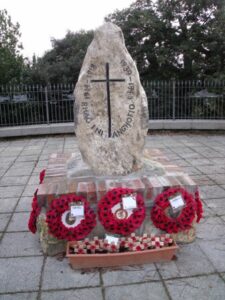
The Great War, 1914-1918
Percy George Adolph, Private, 13150, Welsh Regiment. Percy had been born at Angle, and was the only son of George and Mary Adolph, later of Continental, Goodwick, Fishguard. He enlisted at Haverfordwest into the Army, and was posted to the 1st Battalion, Welsh Regiment. The battalion was stationed in India at the outbreak of war, and was recalled to Britain, where it joined 84 Brigade, 28th Division on 22 December 1914, at Hursley Park. During January 1915 it moved to France, landing at Le Havre and moved to the Western Front, where it saw its first major action during the Second Battle of Ypres. The 1st Welsh landed on 18 January and spent their first night in France in a cotton shed in the Docks at Le Havre, before entraining the following day for Hazebrouck, and marching to Merris. The 1st Welsh then saw their first taste of the front line trenches at Hill 60. After a spell in the line, they rested a few days before moving back into the line at the Bluff on the night of 15 February 1915. The trenches were in an awful state, and not deep enough for safety and during the next two days, the 1st Welsh lost 28 men killed and a further 29 wounded while bringing the trenches up to standard. Percy was killed here on 17 February 1915. He was just 18 years old, and as his grave was lost in further fighting in the area, he is commemorated on the Ypres (Menin Gate) Memorial, Belgium.
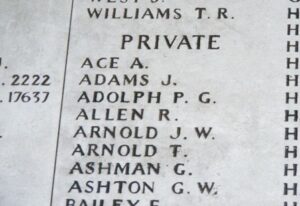
Ernest G. Brinn, Lance Corporal, 46723, Royal Engineers. Ernest was the son of Robert and Elizabeth Brinn, of 14, Kingsbridge, Pembroke. He worked for the Great Western Railway prior to the war, and was based at Goodwick, where he worked as an engine driver. Ernest joined the Royal Engineers on 7 September 1914, and was posted to the 34th Divisional Signal Company. Ernest was due to move to Gallipoli from 4 July 1915, but was transferred, and posted to France, landing on 10 September 1915, where he was attached to the Army Corps Cable Section in France. He was wounded at Loos, and died of his wounds at No. 25 Field Ambulance on 9 August 1916. Ernest was 25 years old, and is buried in Vermelles British Cemetery, France.
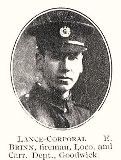
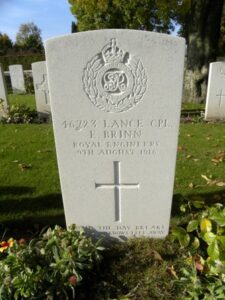
Jeremiah Cullanhan, Private, 87850, King’s Liverpool Regiment. Jeremiah was the son of Jeremiah and Jane Cullanhan, of Castletown, Kennigh, Co. Cork and the husband of Margaret O’Grady (formerly Cullanhan). Jeremiah lived in Goodwick prior to the War, and enlisted at Chatham into the army. He was posted to the 11th Battalion, King’s Liverpool Regiment, the Pioneer battalion to the 14th (Light) Division. The Division had the dubious honour of being the first Division to be attacked by flamethrowers in the War, at Hooge, and afterwards fought on the Somme, and then moved to Ypres, fighting at Passchendaele. Jeremiah probably joined the battalion early in 1918, and was Killed in Action on the third day of the German Spring Offensive, during the Battle of St. Quentin, on 23 March 1918 aged 28. He is commemorated on the Pozières Memorial, France. Jeremiah is not commemorated locally.
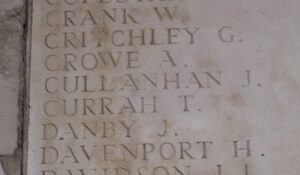
Owen Thomas Cunningham, Private, 13515, South Wales Borderers. Owen was born at Pontypool in 1895, the son of Walter and Martha Cunningham. His parents were both from Goodwick, but had moved to Pontypool to find work. Owen enlisted at Newport into the 2nd Battalion, South Wales Borderers. The 2nd SWB were in China at the outbreak of war, and successfully captured the German Garrison at Tientsin before returning to Britain, where it joined 87 Brigade, 29th Division. The Division moved to Gallipoli via Egypt, landing on 25 April 1915, and fought on the Peninsula throughout the entire campaign. Owen was killed when the 2nd SWB were advancing through Gulley Ravine on 8 May 1915. He has no known grave, and is commemorated on the Helles Memorial, Gallipoli.
James Lloyd Davies, Gunner, 371137, Royal Garrison Artillery. James was born in 1896, the son of Hugh and Margaret Davies, of 3, Cross Street, Dyffryn, Goodwick. He enlisted into the Pembroke Battery, Royal Garrison Artillery on 29 May 1913, and went to France with the battery on 14 June 1916. He was wounded within a month of being in France, and returned home for treatment, before heading back to France on 1 April 1918. James was wounded again on 24 September 1918, and again returned home for treatment. He survived the war, but died of Pthisis brought on by his war service, on 7 February 1920. James has only recently (January 2012) been accepted for commemoration by the CWGC as a result of my research. They were going to add his name to the Brookwood (1914-1918) Memorial, but with some detective work from Les Nixon and relatives at Fishguard, his grave has been found at Hermon Baptist Burial Ground, and the CWGC have erected a new headstone for him.
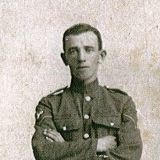
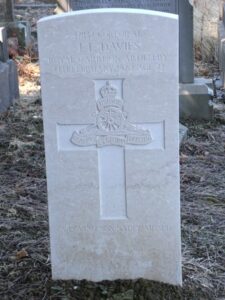
Richard Davies, Private, 34034, South Lancashire Regiment. Richard was born in Whitland, the son of Thomas and Julia Ellen Davies, and the family moved later to The Post Office, Goodwick. Richard enlisted at Fishguard into the Welsh Regiment, with the service number 2405, but must have been wounded at sometime, resulting in his transferring into the 7th Battalion, South Lancashire Regiment, part of 56 Brigade, 19th (Western) Division. The Division had arrived in France in July 1915 and saw considerable action during the Battle of Loos, before moving to the Somme area, where it attacked and took the village of La Boiselle. After a brief rest period, they took to the line again, fighting at Pozieres, and then spending time at the Ancre, where Richard was Killed in Action on 14 November 1916. His body was lost in the terrible conditions in the Ancre valley, and he is commemorated on the Thiepval Memorial, France.
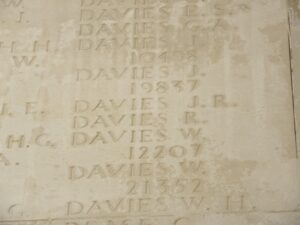
Patrick William Dempsey, Sapper, WR/263588, Royal Engineers. Patrick was the son of John and Margaret Dempsey, of Goodwick. He had originally enlisted into the Royal Engineers, before a short spell of service with the Welsh Regiment, but was transferred back to the Royal Engineers, and posted to the 234th Light Railway Operating Company in France. Patrick died in France on 15 August 1919. He was 21 years old, and is buried in Houchin British Cemetery, France.
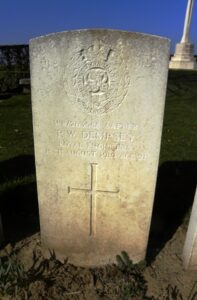
Daniel Donovan, Private, 1344, Royal Munster Fusiliers. Daniel was born at Ballydehob, Co. Cork, the son of Patrick and Catherine Donovan, of Lisheen, Creagh, Ballydehob. He possibly worked on the Irish Ferries, and enlisted at Goodwick into the 1st Battalion, Royal Munster Fusiliers. The Battalion formed part of 48 Brigade, 16th (Irish) Division. The Division fought with distinction on the Somme in 1916, but Daniel was Killed in Action just before the Division moved South to the Somme, on 27 July 1916, aged 36. He is buried in Philosophe British Cemetery, Mazingarbe, France. Daniel is not commemorated locally.
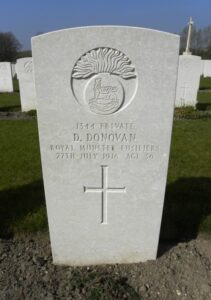
Edward Barfort Drake, Captain, Royal Air Force. Edward was born at Weymouth on 13 February 1898, the son of William and Kate Drake. The family moved to Pembrokeshire, residing first at Neyland, then at Goodwick, where William worked as a Marine Engineer. Edward served with the Royal Naval Air Service, and sat his pilots certificate in an Avro Biplane, at the Royal Naval Air Station, Redcar on 26 October 1916. Edward was then posted to France where he joined 9 Squadron, Royal Naval Air Service. On 1 January 1918 Edward was promoted Flight Lieutenant. On 1 April 1918 the Squadron was formed into 209 Squadron, Royal Air Force, based at Clairmarais, and was equipped with the Sopwith Camel, single seat fighter. By the summer of 1918 Edward had become an Ace. His fourth kill, on the evening of 27 June 1918, came when he shot up a Pfalz D.III over Warfusée. The Pilot, Helmut Steinbrecher, jumped from the burning plane, and made history by becoming the first pilot to successfully deploy a parachute in combat. Less than two months later, on 29 September 1918, Edward was reported missing in action, his Camel (Serial E4376) having deemed to have been shot down by ground fire. Edward has no known grave, and is commemorated on the Arras Flying Services Memorial, France.
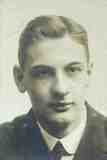
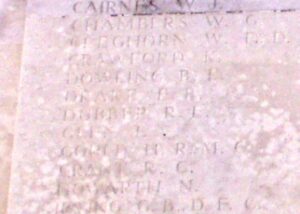
Francis William Dunstan, Corporal, C/7112, Kings Royal Rifle Corps. Francis was born at Goodwick in 1897, the son of William and Frances Amy Dunstan. The family later resided at 3, Clarendon Road, Walthamstow, London. Francis enlisted at London into the army, and was posted to the 18th Battalion, Kings Royal Rifle Corps, which was attached to 122 Brigade, 41st Division. The Division moved to France in May 1916, and began familiarisation with trench warfare in the areas of Ploegsteert and the Douve valley, south of Ypres. They remained here until August 1916, when they moved to the Somme, and took part in the Battle of Flers-Courcelette, and the Battle of Le Transloy, before moving to positions south of Ypres in 1917. Here they took part in the Battle of Messines, before moving further north, where they fought at the Battle of Pilckem, and the Battle of the Menin Road. The Division then moved to Italy, and fought there until being brought back to France as a consequence of the German Spring Offensive of 21 March 1918, and fought on the southern sector of the Somme. They then fought at the First Battle of Arras, before being withdrawn, and sent north to Flanders where they held a relatively quiet sector near Ypres. Francis was wounded during the build up to the great advance in Flanders, and died of his wounds at Remy Casualty Clearing Station on 9 August 1918. He was 21 years old, and is buried in Lijssenthoek Military Cemetery, Belgium. Francis is not commemorated at Goodwick, probably as there was no family still there to place his name on the memorial.
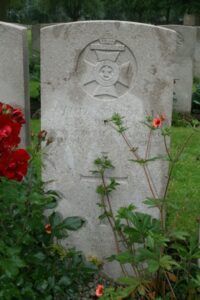
Henry Stephen Evans, Private, 46471, Welsh Regiment. Henry was the son of Henry and Martha Evans, of 14, Plasygamil Road, Goodwick, and the husband of Elizabeth Evans, of Cwmbrechfa, Llanycefn, Clynderwen. He enlisted at Fishguard into the army, and was posted to France to join the 9th Battalion, Welsh Regiment, which was attached to 58 Brigade, 19th (Western) Division. The Division had been in France since July 1915, and had fought at the Battle of Loos. In 1916 it gained a high reputation during the Somme offensive, and spent the winter of 1916/17 on the Somme. Henry was killed during an attack by the 9th Welsh on 2 March 1917, on a portion of the trench system north of Pusieux, called Knife and Fork Trench. He was 26 years old, and is commemorated on the Thiepval Memorial, France.
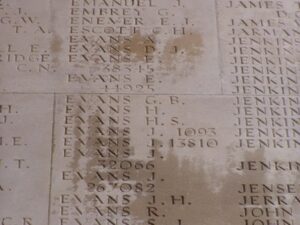
John Llewellyn Evans, Gunner, 188094, Royal Field Artillery. John was the son of David and Martha Evans, of Oxford House, Goodwick. He served with the 98th Battery, Royal Field Artillery, which was attached to the Indian Army. Little is known of John, but he died in India on 24 July 1917, aged 31. He is buried in Nowshera Military Cemetery, which is now in Pakistan, but is officially commemorated on the Delhi Memorial (India Gate), India.
Ernest Edwin Goddard, Corporal, R/3414, Kings Royal Rifle Corps. Ernest was born at Reading, Berkshire in June 1887. He resided at Goodwick prior to the war, and enlisted there into the army. Ernest was then posted to the 9th Battalion, Kings Royal Rifle Corps, which moved to France on 20 May 1915 attached to 42 Brigade, 14th (Light) Division. The Division was to see its first action during the Action of Hooge, where the Division were the first to be attacked by the German use of flamethrowers. They then fought at the Second attack on Bellewaarde. Ernest was killed at Ypres on 25 September 1915. He was 28 years old, and is commemorated on the Ypres (Menin Gate) Memorial, Belgium.
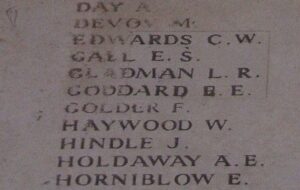
Alfred Blencowe Gray, Seaman, Mercantile Marine. Alfred was born at Neyland in 1891, the son of William Thompson Gray and Bessie Gray, of Marine Villa. William was a Station Master at Neyland, and prior to his death in 1909 moved his family to Glanymor, Goodwick, where Bessie ran a Boarding House. Alfred served his apprenticeship at Trinity House, and later served with the Mercantile Marine, aboard the SS Glengyle. Alfred survived the sinking of the Glengyle by the German Submarine U34 on 1 January 1916. He survived the war, but died in Pembrokeshire on 14 May 1919, aged 28 and is buried in Manorowen Churchyard, near Fishguard. Nothing more is presently known of him, so further research is ongoing, but I cannot find enough evidence to attempt to get him commemorated by the CWGC as a war casualty.
Edgar Harries, Able Seaman, Z/3081, Royal Naval Volunteer Reserve. Edgar was born on 31 December 1897, the son of Thomas and Margaret Harries, of Trelimmin, St. Nicholas, Fishguard. He served in the Royal Naval Volunteer Reserve, aboard the S.S. Manchuria, which had been procured by the I.M.M. in 1915 to make up for wartime losses. Edgar was Killed in Action on 17 October 1917 during a battle with a German U-Boat. The Manchuria survived the battle, but Edgar was buried in sea that day. He was just 19 years old, and is commemorated on the Plymouth Naval Memorial, Panel 24.
William James Harries, Stoker 2nd Class, K/31623, Royal Navy. William was born on 4 October 1893, the son of Elias and Dinah Harries, of Penrhiw Farm, Goodwick. He served in the Royal Navy aboard H.M.S. Q1 (Perugia). Perugia was a Q-Ship, which operated as an undercover merchant vessel with hidden guns, and was intended to be used to lure German submarines to their fate. On 3 December 1916, Perugia was off the north-west coast of Italy, in the Gulf of Genoa, when she was torpedoed and sunk by the German submarine U-63. William was 23 years old when he died that day, and is commemorated on Panel 16 of the Plymouth Naval Memorial, Devon. (The photograph of William is courtesy of Chris John).
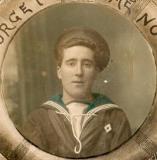
Meager Hearn, Private, 26259, Lancashire Fusiliers. Meager was born in Cardiff. He resided in Goodwick prior to the war, and enlisted at Llanelli into the Royal Field Artillery. He later transferred into the 11th Battalion, Lancashire Fusiliers, who were attached to 74 Brigade, 25th Division. The Division landed in France on 26 September 1915, and were posted to the Vimy area, where they defended Vimy Ridge against a German attack in May 1916, then moved to the Warloy area and attacked on 3 July 1916 near Thiepval. They fought throughout the Battle of the Somme and then moved to Ploegsteert, where they held the line, until taking part in the Battle of Messines in June 1917. Meager was killed in action during the Battle of Messines, on 7 June 1917. He has no known grave, and so is commemorated on the Ypres (Menin Gate) Memorial, Belgium. Meager is not commemorated locally.
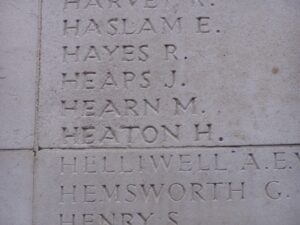
Griffith John, Private, 54323, Royal Welsh Fusiliers. Griffith was born at Llanwnda in 1896. He was raised by his grandparents, Abel and Elizabeth John at Llanwnda, before becoming a farm labourer prior to the war. Griffith enlisted at Haverfordwest into the 9th Battalion, Welsh Regiment just after the outbreak of war and was subsequently transferred to the 9th Battalion, Royal Welsh Fusiliers, which was attached to 58 Brigade, 19th (Western) Division. The Division crossed to France in July 1915, and moved to positions near Loos, where it took part in the opening attack of the Battle of Loos on 25 September 1915. The following year the Division moved to the Somme, where it took part in the second wave of the attack on Ovillers-La Boiselle on 1 July, capturing the village at heavy cost. It then fought through the Somme Battles of Pozieres and the Ancre in 1916. Griffith was killed during the fighting around Regina Trench on 3 November 1916, aged 20 and is buried in Regina Trench Cemetery, France.
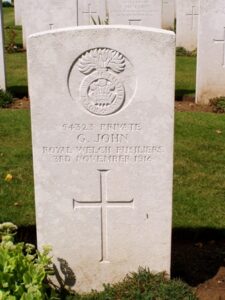
David Rees Jones, Gunner, 371088, Royal Garrison Artillery. David was the son of Thomas and Mary Jones, of Carmarthen. The family lived at 42, Plasygammil Road, Goodwick prior to the war. David enlisted at Fishguard into the Royal Garrison Artillery, being posted to France to join their 182nd Siege Battery, which had moved to France in September 1916. The Battery supported the Canadian attack on Vimy Ridge in 1917, and by the summer of 1918 were still in the Arras Sector. David was seriously wounded during the initial barrage which marked the launch of the great offensive, and died at the 45th Casualty Clearing Station on 23 August 1918. He was 23 years old, and is buried in Bac-Du-Sud British Cemetery, Bailleulval, France.
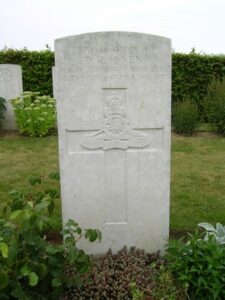
Walter Jones, Rifleman, S/3150, Rifle Brigade. Walter was born at Goodwick, the son of William and Margaret Jones, and enlisted at Fishguard into the army. He was posted to the 13th Battalion, Rifle Brigade, which was attached to 111 Brigade, 37th Division. Late in July 1915 the Division landed in France and concentrated near St Omer. They took part in the Attack on the Gommecourt Salient during the first phase of the Battle of the Somme. Two of the Division’s infantry Brigades, 111 and 112, and the Divisional pioneers were temporarily attached to the 34th Division from 6 July onwards, and Walter was killed while fighting with the 34th Division on 10 July 1916, aged 26. He has no known grave, and is commemorated on the Thiepval Memorial, France.
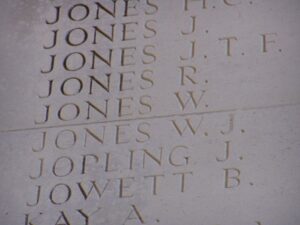
William Francis Jones, First Mate, Mercantile Marine. William was born at Bargoed, Cardiff, the son of William and Harriet Jones. The family had moved to Goodwick prior to William’s second birthday. He later married Margaret Jane Cole, and the couple set up home at 1, Quay Road, Goodwick. William served with the Mercantile Marine as First Mate, aboard the S.S. Birtley, a Newcastle registered collier. On 1 January 1918, Birtley left Dunkirk for the Tyne to collect a cargo of coal. On 3 January 1918, she was off Flamborough Head when she was torpedoed and sank without warning by the German Submarine UB-38, with the loss of all her crew of eighteen. William is commemorated today alongside his fellow crew-members on the Tower Hill Memorial, London. He was 49 years old.
James Kehoe, Private, 6969, Royal Irish Regiment. James was born in Co. Wexford, the son of James and Bridget Kehoe, and the husband of Mary Doran (formerly Kehoe) of Rochestown, Taghmon, Co. Wexford. He enlisted at Goodwick into the 2nd Battalion, Royal Irish Regiment, which moved to France at the outbreak of war, attached to the 3rd Division. The battalion was virtually destroyed during the Battle of La Bassee. They transferred to 12 Brigade, 4th Division, and fought at Second Ypres, and James was mortally wounded at some time during the Battle. He was brought back to the Duchess of Westminster’s Hospital (No.1 B.R.C.S) at Le Touquet, where he Died of Wounds on 13 May 1915, aged 33. James is buried in Le Touquet-Paris Plage Communal Cemetery, France. James is not commemorated locally.
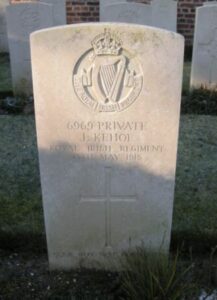
William Joseph Marchant, Private, 37076, Duke of Cornwall’s Light Infantry. William was born at Devonport on 11 September 1898, the son of William and Emily Marchant. He was educated at St. James’s School at Devonport, and was training to become a Civil Engineer when war broke when he enlisted into the army on 15 February 1917. By then his parents were living at The Bungalow, Goodwick. William embarked for Egypt to join the 1/4th Battalion, Duke of Cornwall’s Light Infantry, which was attached to the 75th Division, in January 1918. He became a battalion Lewis Gunner, and was wounded on his first day in action, on 9 April 1918. He died of his wounds in hospital on the following day, 10 April 1918, aged 19, and is buried in Ramleh War Cemetery, Israel. William is not commemorated locally.
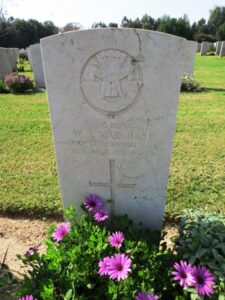
James Murdock McIver, Carpenter, Mercantile Marine. James was born at Goodwick in 1885, the son of James and Edith McIver. He married Lena Mary Belloni Brand at Southampton in the spring of 1918 whilst on leave from the Mercantile Marine. James served aboard the hospital ship HMHS Llandovery Castle. On 27 June 1918, Llandovery Castle was returning from Halifax to Liverpool when she was torpedoed and sunk by the German submarine U-86, 116 miles west of Fastnet. Patzig, the Captain of U-86, realised his mistake in sinking a hospital ship, decided to kill the witnesses, so machine-gunned the survivors who had escaped in three lifeboats. From the total of 258 people, made up of 164 crew, 80 officers and men of the Canadian Medical Corps and 14 nurses), only 24 were rescued in the sole escaping lifeboat by the destroyer HMS Lysander. James was among the dead. He was 31 years old and is commemorated on the Tower Hill Memorial, London. He does not appear to be commemorated locally.
David Miles, Private, 16897, North Staffordshire Regiment. David was the son of James and Margaret Miles, of Pontyago, Goodwick. He enlisted at Haverfordwest on 2 September 1914 into the Welsh Regiment, and in January 1915 was transferred to the North Staffordshire Regiment. In February 1916 David was posted to the 1st Battalion, North Staffs, which was attached to 72 Brigade, 24th Division. In 1916 they took part in the Battle of the Somme, and fought at Delville Wood and Guillemont, before moving north of Arras in early 1917. In April and May, 1917 they fought at the Battle of Vimy, alongside the Canadian Corps, and in June they moved to positions south of Ypres, where they fought during the Battle of Messines. After the successful capture of Messines Ridge, the Division moved further north, and fought at the Battles of Pilckem and Langemarck during Third Ypres. The Division then moved to positions north of St. Quentin over the winter of 1917/18, and were here when the Germans launched their Offensive on 21 March, 1918, fighting a famous defence of the village of Le Verguier. David was listed as missing, presumed killed on the first day of the German attacks, on 21 March 1918. He was 21 years old. David is commemorated on the Pozières Memorial, France.
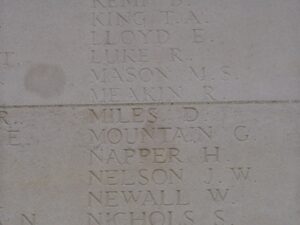
Peter Moran, Leading Boatman, 162528, H.M. Coastguard. Peter was born at Kilmeena, Co Mayo on 29 January 1876, and was the husband of Caroline Moran, of Knave-go-by, Beason, Camborne, Cornwall. He was a fisherman prior to enlisting into the Royal Navy on 29 January 1894 and served continuously until being transferred to H.M. Coastguard Station, Fishguard on 14 March 1914. He died of pneumonia on 2 June 1915, aged 39, and is buried in Fishguard Church Cemetery. Official CWGC records state that he served at HM Coastguard Tenby, but his service papers state Fishguard.
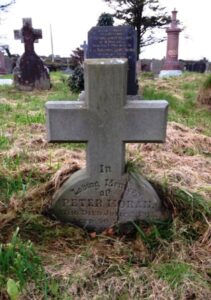
William Harries Morgan, Private, 33798, Welsh Regiment. William was born at Llanwnda in 1894, the son of Mary Morgan and enlisted at Fishguard into 8th Battalion, Welsh Regiment. The battalion was attached to 40 Brigade, 13th (Western) Division, which landed on Cape Helles, Gallipoli in July 1915. They fought on the Pensinsula until being evacuated on 8 January 1916, and by 31 January was concentrated at Port Said, where they held forward posts in the Suez Canal defences. On 12 February 1916 the Division began to move to Mesopotamia, to strengthen the force being assembled for the relief of the besieged garrison at Kut al Amara. By 27 March, the Division had assembled near Sheikh Saad and came under orders of the Tigris Corps, and then took part in the attempts to relieve Kut. However, after these efforts failed and Kut fell, the British force in the theatre was built up and reorganised. The Division then fought at the Battle of Kut al Amara, then at the capture of the Hai Salient and the capture of Dahra Bend. They took part in the passage of the Diyala, in the pursuit of the enemy towards Baghdad, and part of the Division were the first British troops to enter Baghdad. William died during the offensive into Mesopotamia on 4 July 1916. He was 22 years old, and is buried in Basra War Cemetery, Iraq.
William Harries Morgan, Driver, 29446, Royal Field Artillery. William was the son of William and Letitia Morgan, of New Hill Cottage, Goodwick. He enlisted at Bargoed into the Royal Field Artillery, and by 1918 was serving with ‘X’ 12th Trench Mortar Battery, Royal Field Artillery, which was attached to the 12th (Eastern) Division in France. The Division had relieved the 38th (Welsh) Division in the Fleurbaix front line in February 1918, before moving to Albert, where they took part in the First Battle of Bapaume. After suffering heavy losses, the Division withdrew at the beginning of April, to Toutencourt, and spent the coming weeks rebuilding. On 1 July the Division carried out an attack at Bouzincourt. The Division was relieved on 10 July and moved to the area south of Amiens, where it took part in the Battle of Amiens on 8 August, and then moved back to Albert, taking part in the Battle of Albert on 22 August, which saw the launch of the great 100 days offensive, which swept across the wilderness of the old Somme battlefield. The Division was relieved on 30 August and moved back to the Carnoy area. On 4 September 1918 the Division relieved 18th (Eastern) Division east of the Canal du Nord and just south of Manancourt, for an attack on Nurlu, and fought at the Battle of Epehy. They then took part in the Battle of the St Quentin Canal, where they secured the vantage points up to the St Quentin Canal. William was wounded during this drive towards the Hindenburg Line, and died of his wounds on 27 September 1918. He was 28 years old, and is buried in Péronne Communal Cemetery Extension, France.
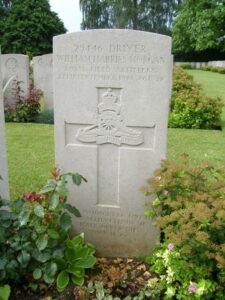
John Harold Morris, Ship’s Steward Assistant, M/8981, Royal Navy. John was born at Goodwick on 14 May 1896, the son of Beatrice Morris. He served aboard the M.F.A. Whitehead. On 15 October 1917, Whitehead was sailing off Suda Bay, Crete, when she was torpedoed and sank by a German Submarine. John was killed in the sinking that day, and is commemorated alongside his crew mates on the Chatham Naval Memorial, Kent. His mother, Beatrice, was by then just living a few miles away from the memorial, at 44, Canterbury Road, Gillingham.
James Morse, Private, 48544, Welsh Regiment. James was the son of William and Ann Morse, of Good Hope, Goodwick. He enlisted at Fishguard into the 3rd Battalion, Welsh Regiment, which was a Home Service unit, used to maintain the supply of reinforcements to the regular battalions of the regiment. James didn’t see front line service, but became ill and died on 12 February 1917. He was 21 years old, and is buried in Pencaer (Harmony) Baptist Burial Ground. James is not commemorated on the Goodwick Memorial.
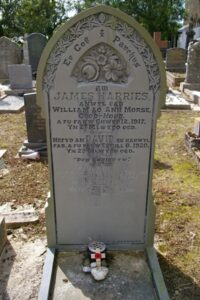
Hugh Kirk Nethercleft, Second Lieutenant, South Wales Borderers. Hugh was born in Croydon on 30 July 1886, the son of Edward William and Mary Rose Nethercleft. He worked for the Great Western Railway prior to the war, and resided at Brynhaf, Goodwick. Hugh was commissioned into the 2nd Battalion, South Wales Borderers, which was attached to 87 Brigade, 29th Division. The Division had seen much service on Gallipoli before being moved to France in 1916, taking up positions on the Somme, near Beaumont Hamel, where it suffered terrible casualties during the Somme Offensive. By May 1917 the Battalion was at Arras, and Hugh joined them here, at Duisans. He fought with the battalion here, and during their next major actions during Third Ypres in August, September and October 1917. At the beginning of November, the Division moved to the Cambrai sector, and took part in the Battle of Cambrai. Hugh was wounded during a German counter-attack, and died of his wounds at Rouen on 25 December 1917, aged 31. He is buried in St. Sever Cemetery, Rouen, France.
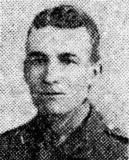
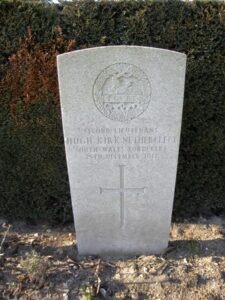
David John Nicholas, Private, 302301, Manchester Regiment. David was born at Llanwnda, the son of David and Mary Nicholas. He enlisted at Fishguard into the army, and was posted to the 1/10th Battalion, Manchester Regiment, which was in France attached to 126 Brigade, 42nd Division. The Division had fought at Gallipoli, and had spent a year in Egypt before moving to France in February 1917, taking over the line near Epehy. In September they moved north to Ypres, where they fought through Third Ypres, until moving to the Coast in September to refit. November 1917 saw them moving to positions at Givenchy, where they remained until moving back south in early 1918. Here they faced the German Spring Offensive of 21 March on the Somme, and fought in the Battle of Bapaume, and then at Arras. The offensive stalled for several months, until an Australian victory at Villers Brettoneux on 8 August saw the tide of war turn. The British attacked the German lines on the Somme on 21 August, with the 42nd Division in the line, and began the great offensive that was eventually to end the war. David was killed during the Battle of the Selle on 20 October 1918, aged 20. He is buried in Belle Vue British Cemetery, Briastre, France.
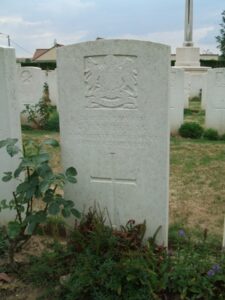
Charles Edwin Norris, Private, 16773, Duke of Cornwall’s Light Infantry. Charles was born in Calstock, Cornwall in 1896, the son of Lucy Norris. He enlisted at Goodwick into the army. He was posted to the 2nd Battalion, Duke of Cornwall’s Light Infantry, part of 82 Brigade, 27th Division. The Division landed in France on 21 December 1914, and saw its first action at St. Eloi, South of Ypres. Charles was wounded at St. Eloi, and brought to Dickebusch where he Died of Wounds on 19 March 1915, aged 19. He is buried in Dickebusch New Military Cemetery, Belgium. Charles is not commemorated locally.
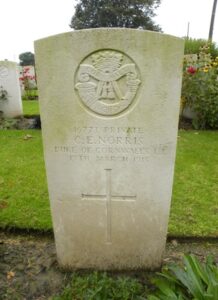
Arthur O’ Keefe, Fireman, Mercantile Marine. Arthur was the son of John and Mary O’Keefe, of Cork. He served as Fireman aboard the SS Hartland. No information can be traced on this ship, but both Arthur and another, unidentified seaman from Hartland are buried together at Llanwnda Cemetery, Goodwick. They both bear the date of their deaths as 22 November 1917.
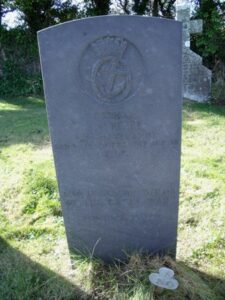
Augustus Charles Owen, MC, Second Lieutenant, Somerset Light Infantry. Augustus was the son of Sir Hugh Charles Owen and Lady Martha Owen, of Laurel Cottage, Goodwick. He was commissioned into the Somerset Light Infantry, and served with their 8th Battalion, attached to 63 Brigade, 21st Division. The battalion landed in France on 10 September 1915 and fought there for the remainder of the war. Augustus was awarded the Military Cross for his bravery during the desperate fighting suffered by the division early in 1918, his citation reading ‘For conspicuous gallantry and devotion to duty. At a critical moment he held his position with a small party of men against an enemy attack delivered after heavy bombardment. By his fine example of courage and determination he enabled the line in that part of the field to be restored’. Sadly Augustus was killed during the Battle of the Aisne, on 6 August 1918, aged 23. He is buried in St. Amand British Cemetery, France.
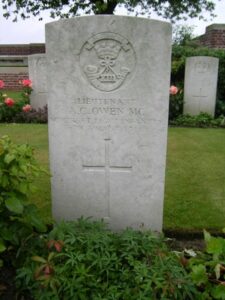
Robert James Peters, Second Engineer, Mercantile Marine. Robert was born at Garnant on 19 August 1886, the son of David and Mary Peters. His father was originally from Milford Haven, but worked for the Great Western Railway, moving the family around west Wales as he progressed in his career. Robert followed his father into the Great Western Railway, becoming an apprentice engineer at Neyland. He then worked for the Mercantile Marine, and had moved to Goodwick prior to the war, serving as Second Engineer aboard the steamship S.S. Inniscara. On 12 May 1918 Inniscarra was en route from Fishguard to Cork, carrying a general cargo, when she was torpedoed and sunk by the German submarine U-86, ten miles off Ballycottin Island, with the loss of 28 lives. Robert was 31 years old when he died that day, and is commemorated on the Tower Hill Memorial, London. Robert does not appear to be commemorated anywhere locally.
James John Phillips, Private, 3804, Welsh Regiment. James was the son of William and Sarah Phillips, of Bwlch-Y-Rhos, Goodwick. He married Edith Tegan in 1914, and the couple lived at 5, Jubilee Terrace, Wallis, Fishguard. He enlisted at Fishguard into the 6th Battalion, Welsh Regiment, which landed in France in August 1914. After service at Calais, the battalion joined the 28th Division on 5 July 1915, before joining the 1st Division at Loos, where it became the Divisional Pioneer Battalion. In the Summer of 1916, the Division moved to the Somme, where it fought during the opening of the Somme Offensive at the Battle of Albert, then at Bazentin, Pozieres, Flers-Courcelette and Morval. James was killed in action on the Somme on 31 December 1916, while the 6th Welsh were at work near Fricourt Wood. He was 23 years old, and is buried in Warlencourt British Cemetery, France. James is not commemorated on the Goodwick Memorial, but at Fishguard.
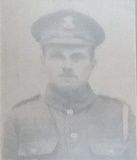
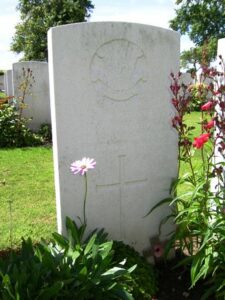
James Rees, Private, 13047, Welsh Regiment. James was born in Tenby, moving with his parents Thomas and Margaret Rees, to 1, Brynteg, Goodwick. He enlisted at Fishguard into the 2nd Battalion, Welsh Regiment, part of 3 Brigade, 1st Division. The Division was one of the first in France, fighting at the Battle of Mons, before retreating down toward the Aisne, where the Germans were eventually stopped. They then moved North to Ypres, taking part in the First Battle Ypres, where the German drive towards the Channel ports was stopped. James survived the terrible rigours of First Ypres, but was wounded when the Germans renewed their offensive on the Salient, and died of wounds on 25 April 1915. He was 23 years old, and is buried in Poperinghe Old Military Cemetery.
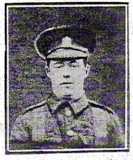
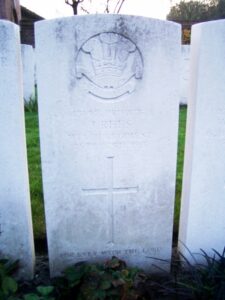
James Ivor Rees, Rifleman, R/3412, King’s Royal Rifle Corps. Ivor was born at Llanstadwell in 1892, the son of James and Sarah Rees. The family later moved to Goodwick, and Ivor enlisted there into the army. He was posted to the 12th Battalion, King’s Royal Rifle Corps, which was attached to 60 Brigade, 20th (Light) Division. On 22 July 1915 the battalion landed in Boulogne, and moved to the Fleurbaix Sector for trench familiarisation and training. When the Battle of Loos was launched on 25 September 1915 the Division fought a diversionary attack towards Fromelles. Later that year they moved north, and fought at the Battle of Mount Sorrel alongside the Canadian Corps. They then fought through the Somme Offensive, at the Battles of Delville Wood, Guillemont, Flers-Courcelette, Morval and Le Transloy, and took part in the advance to the Hindenburg Line in March 1917. Later that year they fought at Third Ypres, at the Battles of Langemarck, the Menin Road, and Polygon Wood, before moving south in November, to take part in the Battle of Cambrai. They remained in the area between Cambrai and St. Quentin over the winter of 1917/18 and were attacked there by the German Spring Offensive of 21 March 1918, suffering heavy casualties over the coming days. Ivor was killed in action on 29 March 1918, aged 25. He has no known grave, and is commemorated on the Pozières Memorial, France.
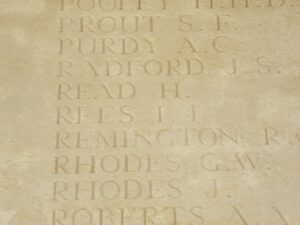
John Edward Reynolds, Private, G/19196, Royal Sussex Regiment. John was the son of John and Hannah Reynolds, of 11, Plasygamil, Goodwick. He enlisted at Fishguard in June 1915 into the 15th Battalion, Welsh Regiment, which was the Carmarthen Pals Battalion. John was discharged as underage in February 1916. When he passed 18, John rejoined, and was posted to the 9th Battalion, Royal Sussex Regiment, which was attached to 73 Brigade, 24th Division. The Division had been in France since August 1915, and had fought at Loos that year, the Somme in 1916, and at Arras and Ypres in 1917. John would have joined the battalion after the winter of 1917/18, when the division was at positions north of St. Quentin. The division was here when the Germans launched their Offensive on 21 March 1918, fighting a famous defence of the village of Le Verguier. They then fought a brave rearguard action at the Somme Crossings, and then at the Battle of Rosieres and the Battle of the Avre, before being moved to Flanders. Here the Division saw heavy fighting at the First Battle of Kemmel, before moving south again, where they fought during the great offensive, at the Battle of Cambrai, when they attacked the Hindenburg Line. After the German defences had been breached, the Division pushed on, taking part in the Pursuit to the Selle, the Battle of Valenciennes, the Battle of the Sambre and the Passage of the Grand Honelle. John was killed just a week prior to the Armistice, on 4 November 1918. He was just 18 years old, and is buried in Wargnies-Le-Petit Communal Cemetery, France.
Edward Roberts, Private, A42772, Canadian Infantry. Edward was born on 18 March 1887, the son of Joseph and Sarah Roberts, of Clyau, Goodwick. He had emigrated to Canada prior to the war, where he worked as a miner. Edward enlisted on 21 May 1915 into the Canadian Army, and was posted to France to join the 2nd Battalion (Eastern Ontario), which was attached to 1st Canadian Brigade, 1st Canadian Division. The Division had been in France since August 1914, and had taken part in the desperate defence of Ypres, facing gas attacks there in 1915. After further fighting at Mount Sorrel, south of Ypres, in June 1916, the Canadians moved to the Somme, where they attacked Courcelette. Edward was wounded on the Somme, and was evacuated to the Base Hospital at Boulogne for treatment. He died there of his wounds on 24 September 1916, aged 29, and is buried in Boulogne Eastern Cemetery, France.
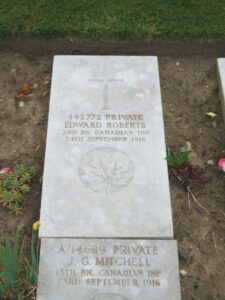
James Sellwood, Private, 260403, Gloucestershire Regiment. James was the son of Rufus and Alice Selwood, of Hawkesbury, Gloucester. Rufus passed away in 1899, and Kate remarried, moving to 12A, Katie Street, Blaengarw, Bridgend. James resided at Goodwick prior to the war, where he worked for the Great Western Railway, and enlisted at Fishguard into the Monmouthshire Regiment. James was later transferred into the 12th Battalion, Gloucestershire Regiment, which was attached to 95 Brigade, 32nd Division. At the end of December 1915 the Division was in France, and the following year took part in the opening of the Somme Offensive, fighting at the Battle of Albert, the Battle of Bazentin, the Battle of the Ancre and the resulting Operations on the Ancre. They remained here over the winter, and in March 1917 followed the German Retreat to the Hindenburg Line. Later that year the Division moved to Ypres, and James was killed there on 4 October 1917. He was 18 years old, and is commemorated on the Tyne Cot Memorial, Belgium.
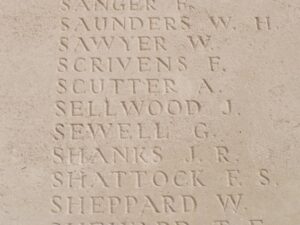
James Shanahan, Private, 2298, Australian Infantry. James was the son of Bridget Shanahan, of Carrick-on-Suir, Ireland. His father died when he was a child and his mother re-married David Russell, before the entire family moved to 7, Harbour Village, Fishguard. James had served with the Royal Navy aboard HMS Queen for several years prior to working on the Fishguard to Rosslare service, aboard the S.S. St. Patrick, and had emigrated to Australia just before the war. He enlisted at Wodonga, Victoria into the 6th Battalion, Australian Infantry on 19 November 1914. He embarked for Egypt with the 2nd reinforcements for the battalion and landed with the battalion at Gallipoli on 25 April 1915. Co-incidentally, the landings were supported by, among other ships, HMS Queen. James survived the initial fighting to gain a foothold on the Peninsula, but was killed in action at ANZAC on 13 July 1915, aged 28. He is buried in Shrapnel Valley Cemetery, Gallipoli.
Reginald Archibald Sharp, Second Lieutenant, Royal Garrison Artillery. Reginald was the son of Captain Richard Sharp and Hannah Sharp, of Goodwick. He married Lilian Mary Jackson on 28 December 1912, and the couple lived at 7, Lynsted Lane, Teynham, Sittingbourne, Kent. He was commissioned into the Royal Garrison Artillery, and was posted to France to join their 47th Siege Battery, which was on the Somme. Reginald was killed on the Somme, during the assault on Delville Wood, on 2 September 1916 when his battery was in support of the assaulting troops. He was 28 years old, and is buried in Péronne Road Cemetery, Maricourt, France.
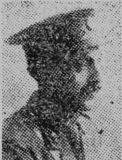
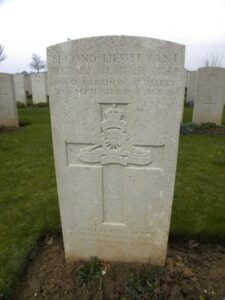
John Steel, Stoker, 276964, Royal Navy. John was born on 28 November 1874. He married Fanny, of 10, Harbour Village, Goodwick on 22 September 1900, and the couple had two sons, Richard John Steel, and Edward James Steel. John was a long serving Stoker in the Royal Navy, and had gained a Lifesaving Medal prior to the war. At the outbreak of war, John was a reservist, and was called up for service, joining the crew of the mothballed Battleship HMS Goliath, which was at Pembroke Dock. Upon the outbreak of war, Goliath was re-commissioned, joining the 8th Battle Squadron. In March 1915 she departed for the Mediterranean, to support the Gallipoli landings. On 13 May 1915, Goliath was anchored off Cape Helles when she was struck by two torpedoes which had been fired by the Turkish Torpedo Boat Muavenet. She exploded and sank almost immediately, with the loss of 570 of her crew, including John. John was 40 years old, and is commemorated on the Plymouth Naval Memorial, Devon.
Benjamin Thomas, Stoker, K/27643, Royal Navy. Benjamin was born on 17 March 1893, the son of Thomas and Martha Thomas, of Llanwnda. He married Annie prior to the war, and the couple lived at 34 Brynhyfryd, Cwmaman, Aberdare, Glamorgan. Benjamin joined the Royal Navy, and served as Stoker 1st Class aboard the Battleship H.M.S. Revolution, which served in the 1st Battle Squadron of the Grand Fleet. (She survived the War, going on to serve during WW2 also). Benjamin was taken ill whilst aboard her, and brought ashore to Hospital. He Died of Sickness on 8 May 1918, and is buried in Aberdare Cemetery.
William Vittle, Private, 26537, Welsh Regiment. William was born in 1868, the son of Thomas and Mary Vittle, of Llanwnda. He enlisted at Fishguard into the army, and sometime in 1915 was posted to the 2nd Battalion, Welsh Regiment, which was in France attached to 3 Brigade, 1st Division. William probably joined the Battalion before the Battle of Loos, and fought with them during the action at the Hohenzollern redoubt. In 1916 the Division moved south to the Somme, where they fought during the opening of the Somme Offensive at the Battle of Albert, then at Bazentin, Pozieres, Flers-Courcelette and Morval. William was killed at Morval on 8 September 1916, aged 48. He has no known grave, and is commemorated on the Thiepval Memorial, France. There is some confusion with William, as another man of that name, also from Llanwnda, was wounded and discharged after serving with the 9th Welsh.
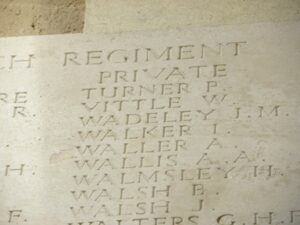
Charles Archibald Walters, Gunner, 371208, Royal Garrison Artillery. Charles was born in Neyland in 1896, the son of Arthur and Minnie Walters. At some time after 1911 the family moved to 70, Harbour Village, Goodwick, where Charles took up work on a farm. He enlisted at Stack Rock Fort into the Pembroke Battery, Royal Garrison Artillery on 16 January 1915. Two months later, he was posted to 114 Siege Battery, and served in France from 14 June 1916. After almost a year on the Western Front, Charles became ill, and returned to England. He then spent two more years on home service, before being discharged from the army due to ill health on 12 May 1919, and was awarded a war pension. He died on 4 April 1920, aged 24, and was buried in Llanwnda Cemetery, Goodwick on 8 April 1920. Charles was accepted for commemoration by the CWGC on Saturday 26 April 2014, as a result of my research, and the CWGC have erected a new headstone to mark his grave.
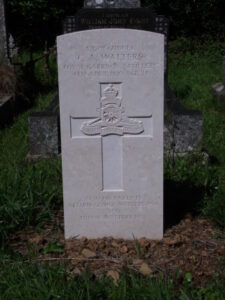
William Charles Wilby, Private, 6215, Oxfordshire and Buckinghamshire Light Infantry. William was born on 29 August 1877, the son of William and Mary Wilby, of Buckingham. Sometime prior to the war, he had moved with his wife, Annie Wilby, to 34, St. David’s Place, Goodwick, where he worked for the Great Western Railway. He was originally from High Wycombe, and enlisted there into the 2nd Battalion, Oxfordshire and Buckinghamshire Light Infantry. The battalion moved to France in August 1914 attached to 5 Brigade, 2nd Division. They moved to Belgium, where they fought at the Battle of Mons, and retreating southwards, fought at the Affair of Landrecies, the Rearguard Actions of Villers-Cotterets, and at the Battle of the Marne where the German offensive was stopped. The Germans retreated north, and the BEF met them, fighting at the Battle of the Aisne. The 2nd Division were then moved to Flanders, where they fought at the First Battle of Ypres, when the German sweep through Flanders was stopped, and remained there throughout the first winter of the war. In 1915 they took part in the Battle of Festubert. William was killed at Festubert on 16 May 1915. He was 38 years old, and is commemorated on the Le Touret Memorial, Richebourg L’Avoue, France.
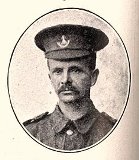
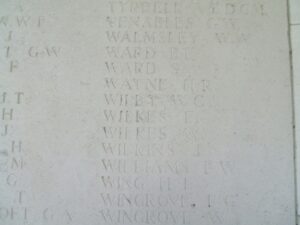
World War Two, 1939-1945
Edgar Ross Beard, Chief Officer, Merchant Navy. Edgar was born on 31 October 1895, the son of Roland and Annie Beard, and the Husband Of Amy Irene Beard, Of Glasgow. He served in the Merchant Navy as Chief Officer aboard the SS Baron Carnegie, an Ardrossan registered cargo ship. Baron Carnegie left Swansea in ballast and joined up with the Halifax bound Convoy OB-334, which left Liverpool on 11 June 1941. The ship was to depart the convoy at a later date and position in the Atlantic and head for the African port of Takoradi. Unfortunately the very same day the ship was attacked and damaged by German aircraft west of the Bristol Channel, killing 25 crew. The ship was taken in tow by the tug SS Seine, but sank on 11 June 1941. Edgar was 45 years old, and is buried in Llanwnda Cemetery, Goodwick.. He is not commemorated locally.
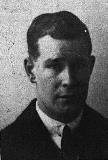
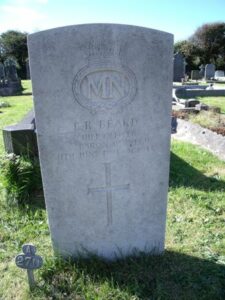
Peter Warren Berry, Flying Officer, 174490, Royal Air Force Volunteer Reserve. Peter was the son of William George and Gertrude Berry, of Sussex. He married Nancy Mona Lanham, of Goodwick in 1942. He was a lorry driver prior to the war, then enlisted into the Royal Air Force in September 1940. He then trained as a Pilot, spending some time in West Africa before being posted to a Coastal Command base at Ross-Shire, Scotland, which was equipped with the Short Sunderland. Peter died on 14 March 1945, when his Sunderland failed to return from an anti-submarine patrol over the North Sea. He was 24 years old, and is commemorated on the Runnymede Memorial, Surrey. (The photograph of Peter is courtesy of Chris John).
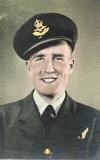
William George Brickle, Canteen Manager, C/NX 195, Royal Naval Canteen Service. William was the son of William and Sarah Brickle, of Monkton, and the husband of Mary Margaret Annie Brickle, of Goodwick, Pembrokeshire. He served with the Royal Navy, aboard HMS Walney. Walney was a former US Coastguard utter, which had been leased to the Royal Navy. She had served on the Atlantic Convoys early in the war, under the command of Western Approaches Command, and was nominated for special duties during Operation Torch, the Allied invasion of North Africa. Her task was to break into Oran harbour, so she sailed from the Clyde on 26 October 1942, as part of the escort for the military convoy MKF-1 to Gibraltar. On arrival in November, she embarked troops to carry out a landing inside the harbour. The operation commenced on 8 November 1942, but rapidly ran into trouble, when Walney came under heavy fire from shore defences, and rammed the outer, and then the inner booms, causing her to sink after being struck by shells from the French sloop La Surprise. Over 80 of her crew and most of the troops being carried went down with the ship. William was one of the men killed aboard Walney on 8 November 1942. He was 33 years old, and is commemorated on the Chatham Naval Memorial, Kent.
Patrick John Browne, Fusilier, 4202900, Royal Welch Fusiliers. Patrick was the son of Mr. and Mrs. William Browne, and the husband of Margaret Browne, of Goodwick. He served with the 7th Battalion, Royal Welch Fusiliers, which was attached to 158 Brigade, 53rd (Welsh) Division. Patrick died on active service, while the Division was training in Kent for the Normandy landings, on 14 April 1944. He was 26 years old, and is buried in Llanwnda Cemetery, Goodwick.
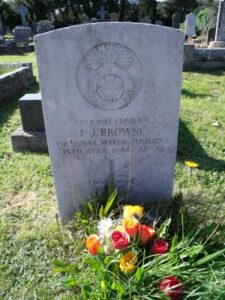
William Frederick Condliffe, Chief Steward, Merchant Navy. William was the son of Matthew and Annie Condliffe. He married Alodie May Hayward in 1901, but she had sadly died by 1932. William had a long career in the Mercantile Marine. By the outbreak of the war, he served as Chief Steward aboard the Fishguard Ferry, SS St. Patrick. The St Patrick had left Rosslare for Fishguard early on the morning of 13 June 1941, and was about 12 miles from Strumble Head when she was attacked by German dive bombers. The first bomb struck her between the bridge and the funnel, penetrating the oil tanks and setting them on fire, sinking the ferry within an hour. The majority of the passengers and crew managed to get off the ship, and were rescued and brought to safety at Milford Haven, but William was one of seventeen who died that day. He is commemorated on the Tower Hill Memorial, London.
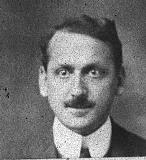
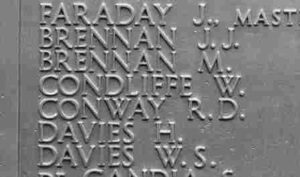
Richard David Conway, Steward, Merchant Navy. Richard was the son of Tom and Caroline Conway. He married Natalie Annie Mabe, of Neyland in 1922, and the couple set up home at Goodwick. Richard served as Steward aboard the Fishguard Ferry, SS St. Patrick. The St Patrick had left Rosslare for Fishguard early on the morning of 13 June 1941, and was about 12 miles from Strumble Head when she was attacked by German dive bombers. The first bomb struck her between the bridge and the funnel, penetrating the oil tanks and setting them on fire, sinking the ferry within an hour. The majority of the passengers and crew managed to get off the ship, and were rescued and brought to safety at Milford Haven, but Richard was one of seventeen who died that day. He was 48 years old, and is commemorated on the Tower Hill Memorial, London.
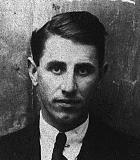
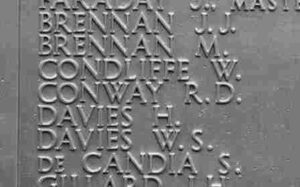
Dennis Francis Corbett, Able Seaman, C/JX 265579, Royal Navy. Dennis was the son of Oliver and Daisy Corbett, and the husband of Colleen Ivy May Corbett, of Goodwick. He served as a DEMS Gunner in the Royal Navy aboard the SS Empire Impala, which was an American Merchant Ship. On 7 March 1943, Empire Impala, in convoy SC-121, was ordered to pick up survivors from the SS Egyptian, which had been sunk by U-230. She was not seen again, as she was torpedoed and sank, possibly by U-591, with the loss of over 40 lives. The official date given for the sinking was 11 March 1943. Dennis was 30 years old, and is commemorated on the Chatham Naval Memorial, Kent.
John William Cotter, Sailor, Merchant Navy. John served in the Merchant Navy, aboard the SS Kellwyn, a Swansea registered steam merchant ship. During July 1941, the Kellwyn was part of Convoy OG-69, when she was struck by a torpedo from the German submarine U-79, about 350 miles west-northwest of Cape Finisterre, and sank with the loss of fourteen men on 27 July 1941. John was 21 years old, and is commemorated on the Tower Hill Memorial, London.
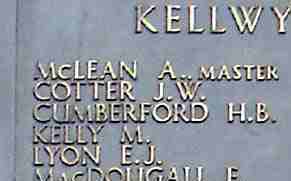
Harold Dale, Steward, Merchant Navy. Harold was the son of Harold and Isabella Dale, of Egremont, Cheshire. He married Dinah Roach, of Goodwick in 1932. Harold served as Steward aboard the SS Avoceta, a Liverpool registered passenger ship. On 18 August 1941 Avoceta sailed, as Commodore Ship of Convoy OG-72, from Liverpool bound for Gibraltar. Upon safely reaching Gibraltar, she was loaded up with a cargo of cork, and mail. Avoceta then set sail for Britain, as part of Convoy HG-73, but the convoy came under attack by a German ‘Wolf Pack’ of U-Boats, losing ten ships on the journey home. Harold lost his life when Avoceta was sunk on 25 September 1941. He was 35 years old, and is commemorated on the Tower Hill Memorial, London.
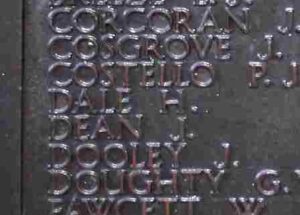
Alexander Davies, Captain, Welch Regiment. Alexander lived at 4, Clement Road, Goodwick, and had served during the war with the 15th Battalion, Welch Regiment on home service. He died on 1 March 1949, aged 53, and is buried in Llanwnda Cemetery, Goodwick. Alexander is not commemorated at Goodwick.
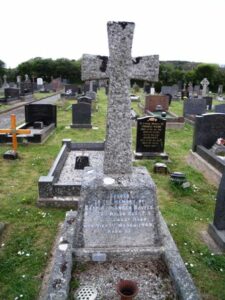
Salvatore de Candia, Second Officer, Merchant Navy. Salvatore was the son of Francis Paul and Catherine De Candia. He was educated at Pembroke Dock Grammar School. He married Dorothy Ruth Davies in 1932, and the couple resided at 1, New Hill Villa, Goodwick. Salvatore served in the Merchant Navy, and at the outbreak of war served aboard the SS St. Patrick, a ferry which served on the Fishguard to Rosslare route. On 13 June 1941, she left Fishguard bound for Ireland. Upon rounding Strumble Head, she was spotted and attacked by German dive bombers, which set the ship on fire. Many of the passengers were rescued, but Salvatore was killed during the attack. He was 37 years old, and is commemorated on Panel 90 of the Tower Hill Memorial, London.
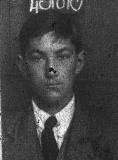

Reginald Clement Duggan, Engine Room Artificer 4th Class, D/MX 55552, Royal Navy. Reginald was the son of James Clement Duggan and Ellen Duggan, of Goodwick. James had served with the Pembrokeshire RGA during the Great War. Reginald served with the Royal Navy aboard HMS Exeter. Exeter was a York Class heavy cruiser, which had been commissioned in 1931. She took part in the Battle of the River Plate in 1939, where the German Pocket Battleship Graf Spee was forced to scuttle herself. Suffering severe damage in the Battle, Exeter had to have a complete refit, and in 1941 rejoined the Atlantic Fleet. Reginald died at sea soon after this, on 22 May 1941. He was buried in sea, and is commemorated on the Plymouth Naval Memorial, Devon. He was 22 years old.
John Delville Morgan Elias, Corporal, 4197448, The Royal Welch Fusiliers. John was the son of Benjamin and Elizabeth Letitia Elias, of Goodwick, and served with the 7th Battalion, Royal Welch Fusiliers. The battalion was a Territorial unit, attached to 158 Brigade, 53rd (Welsh) Division, and landed on the Normandy beach-head in June 1944. It then took part in the fighting to break out of Normandy, and the subsequent drive through France into Belgium and Holland. John was killed in Holland on 25 October 1944. He was 24 years old, and is buried in Uden War Cemetery, Netherlands.
James Faraday, Master, Merchant Navy. James was the Husband of Florence Emily Faraday of Cairniehill, Goodwick, and was Master of the Fishguard Ferry, SS St. Patrick. The St Patrick had left Rosslare for Fishguard early on the morning of 13 June 1941, and was about 12 miles from Strumble Head when she was attacked by German dive bombers. The first bomb struck her between the bridge and the funnel, penetrating the oil tanks and setting them on fire, sinking the ferry within an hour. The majority of the passengers and crew managed to get off the ship, and were rescued and brought to safety at Milford Haven, but James was one of seventeen who died that day. He was 63 years old, and is commemorated on the Tower Hill Memorial, London. His son was also aboard, and died in the sinking alongside his father.
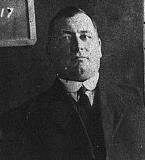
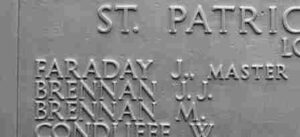
John Michael Faraday, Civilian. John was the son of James Faraday and Emily Faraday, of Cairniehill, Goodwick. He had joined his father James aboard the Fishguard Ferry, SS St. Patrick, for the voyage to Ireland and back. The St Patrick had left Rosslare for Fishguard early on the morning of 13 June 1941, and was about 12 miles from Strumble Head when she was attacked by German dive bombers. The first bomb struck her between the bridge and the funnel, penetrating the oil tanks and setting them on fire, sinking the ferry within an hour. The majority of the passengers and crew managed to get off the ship, and were rescued and brought to safety at Milford Haven, but John was one of seventeen who died that day. He was 19 years old when he died alongside his father, but for some reason is not commemorated on the Tower Hill Memorial, London.
Owen Patrick Faraday, Flight Lieutenant (Pilot), 128067, Royal Air Force Volunteer Reserve. Owen was the son of the late Master James Faraday, and of Florence Emily Faraday, of Cairniehill, Goodwick. He originally served with the 102nd (Pembroke and Cardigan) Brigade, Royal Artillery, and was commissioned Second Lieutenant on 5 November 1938. Owen joined the Royal Air Force after the death of his Father and Brother aboard the SS St. Patrick, and qualified as a Pilot on 20 August 1942, joining 501 Squadron, Royal Air Force. The squadron was a fighter squadron, which had fought during the Battle of Britain with the Hawker Hurricane, before converting to the Supermarine Spitfire in 1941. In July 1944 the Squadron was equipped with Hawker Tempests, and took the role of catching flying bombs over south-eastern England. Owen was killed in action when his Tempest was destroyed on 29 September 1944. He was 31 years old, and is buried in Burnham-on-Crouch Cemetery, Essex.
Gordon Wreford Griffiths, Leading Aircraftman, 1315678, Royal Air Force Volunteer Reserve. Gordon was the son of Alfred and Winifred Ann Griffiths, of Mount Pleasant, Swansea. He was training as a Pilot when he was killed whilst flying Oxford I, R6072 of No 3 SFTS, which collided with Oxford N6267 of the same unit at South Cerney on 26 October 1941. Gordon was 20 years old, and is buried in Llanwnda Cemetery, Goodwick. Gordon is commemorated on the Whitland War Memorial, but not at Goodwick.
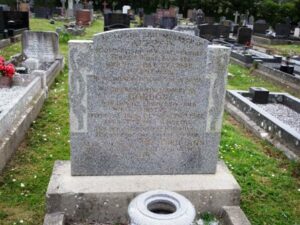
William Daniel Griffiths, Quartermaster, Merchant Navy. William was the son of William Griffiths, and of Catherine Griffiths, of Goodwick, and served as Quartermaster aboard the SS Almeda Star, a London registered luxury passenger liner of the Blue Star Line. She was on route from Liverpool to the River Plate when she was torpedoed by German submarine U-96 on 1 January 1941, with the loss of 360 lives. William was 25 years old, and is commemorated on the Tower Hill Memorial, London.
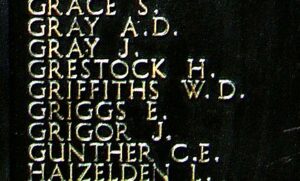
Jane Hughes, Stewardess, Merchant Navy. Jane served as Stewardess aboard the Fishguard Ferry, SS St. Patrick. The St Patrick had left Rosslare for Fishguard early on the morning of 13 June 1941, and was about 12 miles from Strumble Head when she was attacked by German dive bombers. The first bomb struck her between the bridge and the funnel, penetrating the oil tanks and setting them on fire, sinking the ferry within an hour. The majority of the passengers and crew managed to get off the ship, and were rescued and brought to safety at Milford Haven, but Jane was one of seventeen who died that day. She was 57 years old, and is commemorated on the Tower Hill Memorial, London.
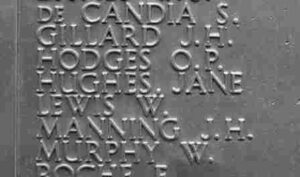
Jack James. Cannot presently be identified.
Thomas A. James. Cannot presently be identified.
William Martin John, Telegraphist, D/JX 156509, Royal Navy. William was the son of John and Elizabeth John, of Goodwick, and served in the Royal Navy aboard HM Submarine P. 48. She had been commissioned in June 1942, after being built by Vickers-Armstrong at Barrow. Moving to the Mediterranean straight after commissioning, P. 48 departed from Malta on 23 December 1942 under the command of Lieutenant M.E. Faber. She was sunk with the loss of her entire crew two days later whilst attacking an Italian convoy in the Gulf of Tunis, after being depth charged by two Italian torpedo boats, the Ardente and the Ardito. The submarine was officially declared overdue on 5 January 1943, and that is the date given for William’s death aboard her. He was 22 years old, and is commemorated on the Plymouth Naval Memorial, Devon.
Robert William Johns, Able Seaman, D/SSX 21077, Royal Navy. Robert was born in Plymouth on 20 April 1919, the son of Robert William Johns and Elizabeth D. Johns (nee Smith), who later moved to Goodwick. He served with the Royal Navy aboard the T-class submarine P. 311. She had been built by Vickers-Armstrong at Barrow-in-Furness and was commissioned in March 1942 under the command of Lieutenant R. D. Cayley. She joined the 10th Submarine Flotilla at Malta in November 1942. On 30 December 1942 she left Malta equipped with two Chariot midget submarines, which had been strapped to her decks, taking part in a mission code-named Operation Principle. Her destination was the Italian port of La Maddalena, Sicily, where she was to launch the two midget submarines in order to attack two Italian 8-inch gun cruisers. At some time between departing Malta and 8 January 1943 she was lost with all hands, after being reported overdue on 8 January 1943 when she failed to return to base. It was assumed that she was mined. The date given for Robert’s death is 8 January 1943. He was 23 years old and is commemorated on the Plymouth Naval Memorial, Devon. The submarine was found by Italian divers in May 2016, still with her two midget submarines lashed aboard.
David Rex Jones, Signalman, 10686826, Royal Army Service Corps. David was the son of Benjamin and Annie Jones, of Goodwick. He served with 41 Base Supply Depot, Royal Army Service Corps, in the Western Desert. David was killed in North Africa on 4 June 1943. He was 19 years old, and is buried in Bone War Cemetery, Annaba, Algeria.
Ernest Aelwyn Price Jones, Petty Officer Cook (S), D/MX 49557, Royal Navy. Ernest was the son of Louis Price Jones and Elizabeth Jane Jones, and the husband of Megan Jones, of Goodwick. He served with the Royal navy aboard HMS Glorious, which was the first ever Aircraft Carrier. Converted from a large light cruiser which had seen action during the Great War, Glorious was commissioned in her new role in 1930. She served with the Mediterranean Fleet after the outbreak of war, but was recalled to the North Sea, where her aircraft took part in air strikes on German troops during the invasion of Norway in 1940. On the morning of 8 June 1940, Glorious was returning as part of a convoy of Royal Naval ships from Norway when she was discovered, along with her two escorts, the destroyers HMS Acasta and HMS Ardent, by the German battleships Scharnhorst and Gneisenau. The carrier and her escorts were sunk in two hours, after putting up a brave fight against the overwhelming power of the Germans. Ernest was 26 years old when he died that day, and he is commemorated on the Plymouth Naval Memorial, Devon.
Morgan Harries Lanham, MID, Leading Seaman, D/SSX 16051, Royal Navy. Morgan was born on 15 January 1916, the son of William Hadley Lanham and Martha Lanham (nee Harries), of Goodwick. He enlisted into the Royal Navy and after training at HMS Drake was posted aboard the O-class destroyer HMS Onslow, which had entered service in 1941. Onslow saw considerable action during the war, and survived the hostilities, being transferred to the Pakistan Navy in 1949. Morgan died aboard Onslow on 31 December 1942 during the Battle of the Barents Sea while Onslow was serving as part of the destroyer escort for Arctic Convoy JW 51B. During the battle Onslow received three direct hits from the German heavy cruiser Admiral Hipper which severely damaged the bridge and engine room. This caused many casualties among Onslow’s crew killing 17, including Morgan, and severely injuring the escort commander Capt Robert St Vincent Sherbrooke. Morgan was buried in sea. He was 26 years old, and is commemorated on the Plymouth Naval Memorial, Devon. He had been Mentioned in Despatches for ‘bravery in northern waters’ during his time at war, which was published in the London Gazette of 27 April 1943. (The photograph of Morgan is courtesy of Chris John).
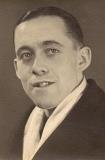
Walter John James, Flying Officer (Air Bomber), 135088, Royal Air Force Volunteer Reserve. Walter was the son of William and Hannah James, of Leicester Villa, Goodwick. He joined the Royal Air Force Volunteer Reserve and after training as an Air Bomber was posted to 83 Squadron, RAF, an elite Pathfinder unit, equipped with the Avro Lancaster. On 1 January 1944 Walter took off from RAF Wyton aboard Lancaster III, Serial ND354, which was part of a group ordered to bomb Berlin. At around 03.00 on the morning of 2 January the Lancaster was hit by enemy fire and blew up in mid-air, crashing near Lutten, about two miles from Vechta. Only one man survived, being thrown out of the doomed aircraft before it crashed. The remainder of the crew, seven men, including Walter, are buried in Sage War Cemetery, Germany. Walter was 29 years old. His father had served with the Royal Garrison Artillery during the Great War.
Harry Gwynne Lewis, Sergeant (W.O. Mech./Air), 550742, Royal Air Force. Harry was the son of Frederick St. George Lewis and Sarah Louisa Lewis, Of Goodwick. He served as an Air Mechanic/ Wireless Operator with 59 Squadron, Royal Air Force. The squadron was a Coastal Command unit, equipped with the Liberator, and by 1943 was based in Ireland, flying on anti-submarine duties. Harry died on active service on 24 June 1944. He was 25 year old, and is buried in Llanwnda Cemetery, Goodwick.
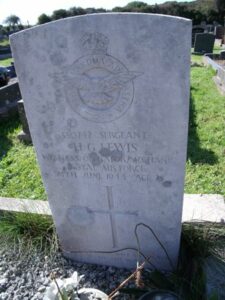
James Harries Manning, Assistant Cook, Merchant Navy. James was the son of Alfred and Martha Ann Manning, and the husband of Catherine Berry Manning, of Goodwick. He served as Cook aboard the Fishguard Ferry, SS St. Patrick. The St Patrick had left Rosslare for Fishguard early on the morning of 13 June 1941, and was about 12 miles from Strumble Head when she was attacked by German dive bombers. The first bomb struck her between the bridge and the funnel, penetrating the oil tanks and setting them on fire, sinking the ferry within an hour. The majority of the passengers and crew managed to get off the ship, and were rescued and brought to safety at Milford Haven, but James was one of seventeen who died that day. He was 34 years old, and is commemorated on the Tower Hill Memorial, London.
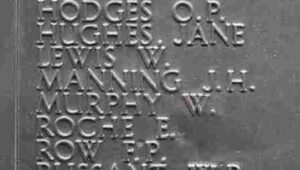
Frank Mathias, Apprentive, Merchant Navy. Frank was the son of Richard and Edith Mathias, of Goodwick, and was an Apprentice in the Merchant Navy, serving aboard the SS Trevarrack She was registered at St. Ives, and was a Cargo Steamer. On 8 June 1941, when on route for Montreal from the Clyde with Convoy OB-329, she was torpedoed in mid Atlantic by the German submarine U-101 and sank SW of Cape Clear. Frank was killed, along with the master, 37 crew members and seven passengers. He was 17 years old, and is commemorated on the Tower Hill Memorial, London.
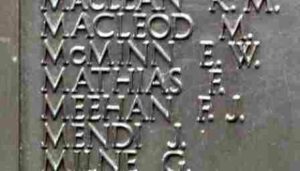
David Byron Morgan, Telegraphist, C/SSX 16333, Royal Navy. David was the son of Robert and Jessie Morgan, of Goodwick, and served with the Royal Navy aboard HMS Widgeon. Widgeon was a Kingfisher Class patrol vessel, and had been launched in 1938, armed with one four-inch anti-aircraft gun and eight smaller guns plus depth charges. David died aboard her on 14 November 1939. He was 24 years old, and is commemorated on the Chatham Naval Memorial, Kent.
William Murphy, Assistant Steward, Merchant Navy. William was the son of Michael Patrick and Margaret Murphy, and the husband of Marjorie S. T. Murphy, of Goodwick. He served as Assistant Steward aboard the Fishguard Ferry, SS St. Patrick. The St Patrick had left Rosslare for Fishguard early on the morning of 13 June 1941, and was about 12 miles from Strumble Head when she was attacked by German dive bombers. The first bomb struck her between the bridge and the funnel, penetrating the oil tanks and setting them on fire, sinking the ferry within an hour. The majority of the passengers and crew managed to get off the ship, and were rescued and brought to safety at Milford Haven, but William was one of seventeen who died that day. He was 31 years old, and is commemorated on the Tower Hill Memorial, London.
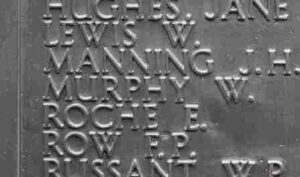
Kenneth Dorrien Nicholls, Lieutenant, 154, Royal Naval Volunteer Reserve. Kenneth was the son of Arthur John Henry and Gertrude Nicholls, and the husband of Eira G. Nicholls, of Goodwick. He served aboard H.M.L.C.T. 154, a Landing Craft which had been designed for carrying Tanks. Kenneth must have been killed during the invasion of France on 21 August 1944. He was 28 years old, and is buried in Mazargues War Cemetery, Marseilles, France.
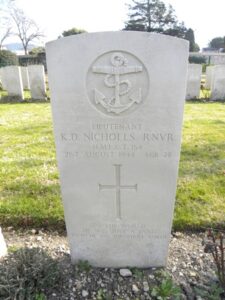
Peter Hubert O’Kelly, Pilot Officer, 2238600, Royal Air Force. Peter was born on 15 April 1928, and served at RAF Driffield, the home of No.203 Advanced Flying School, which was the first fast jet school in the world. There were two sections within the school; No.1 Squadron operated the Gloster Meteor, and No.2 Squadron flew the de Havilland Vampire. Hubert was killed during an air crash on 27 September 1950, and is buried in Llanwnda Cemetery, Goodwick. He was 22 years old.
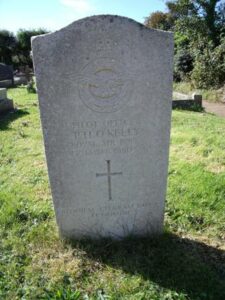
William Rees, Greaser, Merchant Navy. William was the Husband of Phoebe A. Rees, of Goodwick, and served as Greaser aboard the Fishguard Ferry SS St. David. She was commandeered by the Admiralty at the outbreak of war, and was used for evacuation of the BEF at Dunkirk in 1940. The St David was then converted to a hospital ship, and was bombed and sunk during the Anzio landings on 24 January 1944. William was 58 years old when he was killed aboard her that day, and he is commemorated on the Tower Hill Memorial, London.
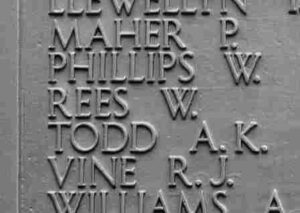
Frank Percival Row, Chief Officer, Merchant Navy. Frank was born in Sussex on 15 February 1900, the son of Henry Frederick and Ethel May Row. He worked for the Great Western Railway, and ended up living at Goodwick, where he became Chief Officer aboard the Fishguard Ferry, SS St. Patrick. The St Patrick had left Rosslare for Fishguard early on the morning of 13 June 1941, and was about 12 miles from Strumble Head when she was attacked by German dive bombers. The first bomb struck her between the bridge and the funnel, penetrating the oil tanks and setting them on fire, sinking the ferry within an hour. The majority of the passengers and crew managed to get off the ship, and were rescued and brought to safety at Milford Haven, but Frank was one of seventeen who died that day. He was 41 years old, and is commemorated on the Tower Hill Memorial, London.
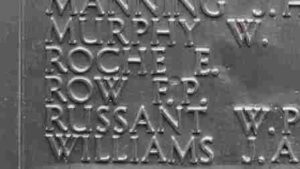
Philip J. Russant, Trooper, 19192872, Royal Armoured Corps. Philip was born at Goodwick on 20 May 1929, the son of Martha Ann Russant (the sister of William Phillip Russant below). He was too young to serve during WW2, but enlisted after the war into the 17th/21st Lancers, which was attached to the Royal Armoured Corps. In 1946 the regiment was posted to Greece on internal security duties. In 1947 it deployed to the Suez Canal Zone and re-equipped as an armoured car regiment, and then moved to Palestine in 1948 on peace-keeping duties. Philip was just 18 years old when he was killed in Palestine on 13 March 1948. He is buried in Haifa War Cemetery, Israel. Philip is not commemorated on any memorial locally. Many thanks to Chris Lanham for supplying the details about Philip.
William Philip Russant, Assistant Steward, Merchant Navy. William was the son of Robert and Pheobe Russant, and the husband of Lily May Russant, of Goodwick. He served as Assistant Steward aboard the Fishguard Ferry, SS St. Patrick. The St Patrick had left Rosslare for Fishguard early on the morning of 13 June 1941, and was about 12 miles from Strumble Head when she was attacked by German dive bombers. The first bomb struck her between the bridge and the funnel, penetrating the oil tanks and setting them on fire, sinking the ferry within an hour. The majority of the passengers and crew managed to get off the ship, and were rescued and brought to safety at Milford Haven, but William was one of seventeen who died that day. He was 34 years old, and is commemorated on the Tower Hill Memorial, London.

Ladner Summers, Second Hand, LT/JX. 241895, Royal Naval Patrol Service. Ladner was the son of William and Clara Summers, of Milford Haven. He married Elizabeth Myfanwy John, of Goodwick while home on leave in 1943. He served with the Royal Navy aboard HM Yacht Tyrant. Ladner was killed at 23, Skelwith Road, London when a German high explosive bomb landed in the street and blew up a gas main on 23 February 1944. He was 28 years old and his body was brought back to Pembrokeshire to be buried in Milford Haven Cemetery.
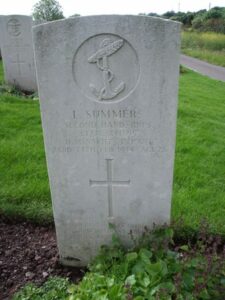
Oswald Frederick Swayne, Engineer Officer, Merchant Navy. Oswald was the son of Frederick A. Swayne, and of Agnes Esther Swayne, of Goodwick. He served in the Merchant Navy as Engineering Officer aboard the MV Lady Glanely, a Cardiff registered Cargo vessel. On 2 December 1940, when on route from Vancouver to London via the Panama Canal, carrying a cargo of wheat and timber, she was torpedoed by German submarine U-101 and sank with the loss of 31 lives. Oswald was 24 years old, and is commemorated on the Tower Hill Memorial, London.
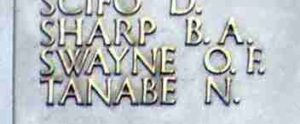
Thomas David Thomas, Gunner, 1605265, Royal Artillery. Thomas was the son of Thomas and Catherine Thomas, of Hebron, Carmarthenshire. He had studied for his B.Sc. prior to the war, before joining the Royal Artillery, serving with the 3rd Heavy Anti Aircraft Regiment, RA. The Regiment served in the Far East. Thomas was captured by the Japanese, and was sent to work on the Burma-Siam Railway. Sadly Thomas died in captivity in Burma, on 6 December 1943 aged 30. He is buried in Thanbyuzayat War Cemetery, Myanmar.
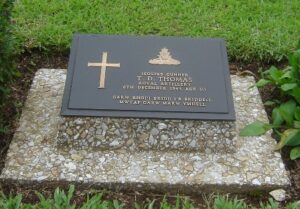
Charles Tompkins, Civilian. Charles was born in Crockham Hill, Kent on 3 December 1895, the son of Joseph and Martha Tompkins. He married Margaret Mary Fenn on 4 October 1919 after returning home from almost three years at sea with the Royal Navy. During World War Two his wife resided at Airmont, Glanmor Road, Goodwick, while Charles served as a Light Keeper at St. Catherine’s Lighthouse, Undercliff, Niton. He was killed when the lighthouse was attacked by German aircraft on 1 June 1943. He was 47 years old. Charles is not commemorated at Goodwick.
Robert John Vine, Greaser, Merchant Navy. Robert was the Husband of M. Vine, of Camden Town, London. He served as Greaser aboard the Fishguard Ferry SS St. David. She was commandeered by the Admiralty at the outbreak of war, and was used for evacuation of the BEF at Dunkirk in 1940. The St David was then converted to a hospital ship, and was bombed and sunk during the Anzio landings on 24 January 1944. Robert was 62 years old when he was killed aboard her that day, and he is commemorated on the Tower Hill Memorial, London.
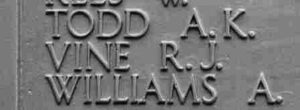
Arthur Williams, Greaser, Merchant Navy. Arthur was the son of William and Emma Williams, and the husband of A. Williams, of Goodwick. He served as Greaser aboard the Fishguard Ferry SS St. David. She was commandeered by the Admiralty at the outbreak of war, and was used for evacuation of the BEF at Dunkirk in 1940. The St David was then converted to a hospital ship, and was bombed and sunk during the Anzio landings on 24 January 1944. Arthur was 63 years old when he was killed aboard her that day, and he is commemorated on the Tower Hill Memorial, London.

John Williams, Private, 7537195, Army Dental Corps. John was the son of Thomas Henry and Sarah May Williams, and the husband of Zena Edith Williams, of Goodwick. He served in North Africa with the Army Dental Corps. John died in North Africa on 19 September 1943. He was 25 years old, and is buried in Massicault War Cemetery, Tunisia.
John Albert Williams, Seaman, Merchant Navy. John was the son of E. and Mary Williams, of Goodwick, and served in the Merchant Navy aboard the Fishguard Ferry, SS St. Patrick. The St Patrick had left Rosslare for Fishguard early on the morning of 13 June 1941, and was about 12 miles from Strumble Head when she was attacked by German dive bombers. The first bomb struck her between the bridge and the funnel, penetrating the oil tanks and setting them on fire, sinking the ferry within an hour. The majority of the passengers and crew managed to get off the ship, and were rescued and brought to safety at Milford Haven, but John was one of seventeen who died that day. He was 23 years old, and is commemorated on the Tower Hill Memorial, London.
Verdun Douglas George Williams, Private, 5502958, The Queen’s Own Royal West Kent Regiment. Verdun was born in Goodwick in 1917, probably the son of Frederick Arthur Williams and Caroline Howlett, and served with the 1st Battalion, The Queen’s Own Royal West Kent Regiment. The battalion joined ‘Operation Torch’, the Anglo-American invasion of French Algeria in November 1942, and fought throughout the tough Tunisian campaign, prior to taking part in the invasion of Sicily and Italy in 1943. Verdun was killed in Italy on 6 July 1944. He is buried in Foiano Della Chiana War Cemetery, Italy. He was 27 years old.
Roland George Herbert Wyles, Marine, PO/X. 105400, Royal Marines. Roland was the son of Edwin Charles Herbert and Alice Lily Wyles, Of Beeston, Nottinghamshire. He served with the 10th Battalion, Royal Marines, and was stationed at Maesgwynne Farm, near Fishguard. On the night of 23 September 1941, a German Stuka dive bomber dropped a single parachute mine which exploded, killing Roland, and two other Marines, Hugh Connolly and Frederick John Brunt. Roland is buried in Llanwnda Cemetery, Goodwick. He was 20 years old. Roland is not commemorated at Goodwick.
